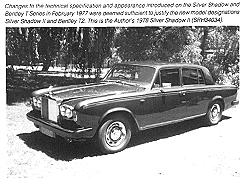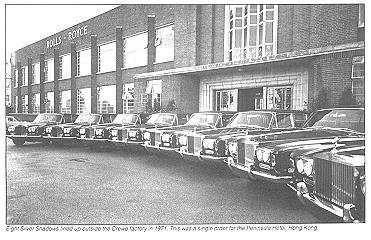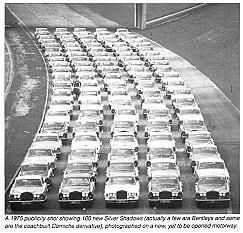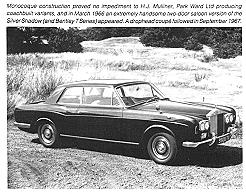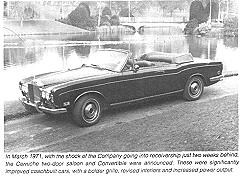From RROCA-info
Thirty Years of the Silver Shadow
A Thirtieth Birthday Celebration of the Silver Shadow and Bentley T Series
By Ron Magrath, 1995
October of this year saw the thirtieth anniversary of the announcement of the then revolutionary Silver Shadow family of motor cars. Western Australia Branch member Ron Magrath tells the story in the following article, adapted from his article in the W.A. Branch newsletter Winged Messenger.
As with any enterprise which throughout its history establishes unassailable standards of excellence, a review of the history and development of the motor cars built by Rolls-Royce is a rewarding experience. However, notwithstanding the many derivatives from basic line models built by the Company, an objective appraisal shows that Rolls-Royce have only produced two distinct models from which all subsequent models can trace their parentage. These two models were, of course, the incomparable 40/50 h.p., or Silver Ghost as it is now known, and the other unquestionably was the Silver Shadow.
The production of motor cars began as simply a side issue for Frederick Henry Royce, for the company that bore his name was principally a manufacturer of heavy electrical equipment including high lift cranes. Indeed, this endeavour commenced with the successful manufacture and sale of electric door bells by Royce and his partner Ernest Claremont, who history records was none too enchanted with the diversion into motor car manufacture. However, once the great man took an interest in motor cars it quickly led to the design and production of the Silver Ghost, which was to continue in its direct form for some 18 years. The Silver Ghost established the chassis design and suspension geometry, together with power train configuration and braking system, which would be perpetuated long past the cessation of Silver Ghost production in 1925, through models built in conjunction with Ghost production or subsequent to it. Although myriad engineering improvements were, of course, introduced with the evolution of the Company's models, including independent front suspension with the 1936 Phantom III, the early principles established with the Silver Ghost lived through until production of the Silver Cloud III ceased at the end of 1965.
Technology is a rapidly developing phenomenon of the 20th century, of late frighteningly so, and to be able to claim a 58 year development heritage cannot be surpassed in automotive development history - such is the legacy of the incomparable Silver Ghost.
Notwithstanding the engineering excellence of the 40/50 and derivatives, automobile construction was not able to claim a contribution to the RollsRoyce Ltd balance sheet. Since 1914 the Company had been producing aircraft engines which, by the conclusion of World War 1, had become the mainstay of the Company's manufacturing activities. That the production of piston aircraft engines ensured the survival of the Rolls-Royce motor car is a fact for which all Rolls-Royce enthusiasts can be thankful. More importantly, that aero engine production led to the design of the Merlin series is a fact for which the whole of the free world can be thankful, as it was this engine that provided the power for the Hurricane and Spitfire fighters of the Royal Air Force which, in the hands of a relatively small number of young and courageous airmen, thwarted the ambitions of world dominance by the Axis powers in the dark days of 1940. But for these endeavours the Rolls-Royce marque might have withered, and it is therefore ironic that it was the Aero Engine Division of the Company that brought it into voluntary liquidation in 1971.
Following World War II Rolls-Royce resumed motor car production, but the cars represented little more than a perpetuation of pre-war design philosophy and became quickly and increasingly antiquated in concept and performance.
By the mid 1950s, while it was obvious that a conceptually new car was required to replace the existing Silver Cloud and Bentley S Series models, Rolls-Royce followed standing principles of extensive testing and evaluation of designs before the new car eventuated. Called Project Burma, preliminary design studies commenced in 1956 from an earlier Project Tibet, a smaller car subsequently subsumed by Burma. Similarly. a new power unit, an aluminium 90 degree V-8 of 6,230 c.c. capacity had been under development since 1952. This new engine was ready before Burma and was introduced in the Silver Cloud II, Bentley S2 and Phantom V in 1959.
Revealed to the public for the first time at the London (Earls Court) Motor Show in October 1965, the Silver Shadow was quickly appreciated for the revolution in Rolls-Royce motor car design that it represented. It was a total and irrevocable break with the past.
Gone was the massive chassis that put all light trucks and most medium commercial vehicles to shame. Gone too was the rigid rear axle with semi-elliptic springs, a feature with its origins in the horsedrawn coach of the 1700s. It was the braking and automatic height control systems, however, which placed the Silver Shadow ahead of all contemporaries. A dual circuit, multiple caliper disc brake system with two camshaft-driven hydraulic pumps supplying 2,500 psi operating pressure backed up by a conventional master cylinder circuit was a far cry from the previous mechanical servo operated system of 1920s origin, and owed more to aircraft practice than to automotive.
By far the most advanced step was the use of aircraft technology in the form of monocoque, or unitary construction of the body shell. Although not new to the automotive industry, Rolls-Royce was not about to introduce the concept until all Company design parameters were met, not the least of those being strength and silence. The shells were produced by Pressed Steel Fisher of Cowley, who had provided all the standard steel body shells since 1946.
Although now devoid of a full separate chassis, truck-strength engineering was still to be found in the sub-frame supporting the power train and front end suspension components. Equally, the rear independent suspension comprising semitrailing arms with a massive transverse differential carrier was of very substantial construction for a passenger car.
The big V-8 has proved to be a superb engine and while technically capable of developing around 600 bhp given the necessary 'treatment', the fact that it was and still is only required to produce about 225 bhp in the Silver Shadow and subsequent (non-turbo) models ensures its longevity, provided of course that the correct service schedules are adhered toOther than on cars for North America, the engine was coupled to the Rolls-Royce four-speed automatic gearbox and fluid flywheel of G.M. 'Hydramatic' derivation, but in 1968 the GM.400 torque converter transmission fitted to American models became standard for all markets. This transmission, brought in complete from Detroit, was probably the best automatic transmission ever devised up until that time.
For driver and passengers the usual standard of luxury was provided in what was essentially a fourseater motor car. Although a fifth person could be carried in the centre of the rear seat, this was a 'crush' provision for relatively short journeys only. Individual front seats limited accommodation to two persons and allowed the between seat console to be used for stowage. The 1950s concept of a six-seat car had never been embraced by Rolls-Royce and with the advent of the Silver Shadow was abandoned entirely.
Although the Silver Shadow series was to enjoy a production run of 15 years, the last Silver Shadow was a substantially different motor car from that displayed for the first time at Earls Court in 1965. Understandably, much development work took place throughout the life of the model and early criticism of imprecise directional control and ride were progressively rectified. Four wheel automatic height control powered by a circuit of the high pressure hydraulic system was a feature of the introductory Silver Shadow, but this was soon deleted from the front suspension where it was found to do very little of the actual levelling work.
Emission control requirements and inevitable weight increases led to an increase in the stroke of the V-8 engine, giving a swept volume of 6,750 c.c. from 1970 onwards, in order to maintain power levels. During 1974 the direct master cylinder braking circuit was deleted, leaving the two independent high pressure systems.
The ultimate modifications to the Silver Shadow/Bentley T family of cars were introduced as a single package in 1977 on the Silver Shadow H and Bentley T2. At the same time, the long wheelbase model received its own distinctive, if confusing, model designation Silver Wraith H. It is disappointing that many authors on the subject of Rolls-Royce and Bentley motor cars dismiss this event, usually with a short paragraph citing automatic split-level air conditioning and rack-andpinion steering as the principal changes. In fact, the car was somewhat transformed in handling and passenger amenities compared to the earlier cars, and included refinements in many areas which would carry through to the next model, the Silver Spirit.
The substitution on the Silver Shadow H of rack-and-pinion power steering for the earlier recirculating ball power steering system enabled the car to be controlled more precisely with little effort. At the same time, the opportunity was taken to change the front end geometry and increasing the track by 6.4 cm. (front) and 5.4 cm. (rear), and the wheelbase by 1.5 cm. These changes significantly reduced the understeer characteristics of the car, improved tyre wear, and overall made the car much more responsive to drive.
The smooth and flexible V-8 soldiered on despite being increasingly strangled by ever increasing antipollution controls which included the use of S.U. type HIF.7 (1 7/8") carburetters on the Silver Shadow II as substitutes for the HD.8 (2") type on the earlier cars. A still rather agricultural exhaust manifold fed into separate discharge pipes which continued to the rear of the car as a visual distinguishing feature of the Silver Shadow II. Other external distinguishing features included a slightly deeper (front to rear) radiator shell, large polyurethane bumpers capped with stainless steel and devoid of overriders, an air dam below the front bumper and, from mid-1978, headlamp washers/wipers. The air dam may well have improved stability at very high speeds as the Company claimed. However, the extra drag it created may just have been offset by the cleaner air-flow under the car as the front end components were no longer exposed. Two bumper suspended fog lights complete the Silver Shadow H front end ensemble.
Inside the car, the whole instrument and controls layout in a completely revised fascia shows cognizance to ergonomic design. All primary instruments and controls are immediately in front of the driver, with ancillary controls and instruments outside this area. The layout had been introduced on the Corniche in 1976 and the basic configuration was still current on the 1995 Silver Spirit models. The automatic air conditioning system, first fitted to the Camargue and then to the Corniche from 1976, is really a climate control system permitting constant, but differing if required, temperatures to be maintained in the upper and lower levels of the cabin, as selected by the driver. Properly maintained, the system works beautifully, but left to the unqualified amateur without test equipment, the operation of the system can deteriorate into an expensive nightmare.
After 15 years of production and around 38,000 examples, including coachbuilt derivatives, production of the most advanced car built by Rolls-Royce until that time. ceased. The model endured the traumatic bankruptcy of the parent Company in 1971, brought about by development cost overruns in production of the RB.211 jet engine by the Aero Engine Division. However, as the Silver Shadow had been returning increasing profit levels since 1968, a new company - RollsRoyce Motors Ltd - was formed as a separate entity and continues to prosper, recessions notwithstanding. as Rolls-Royce Motor Cars Ltd.
That the Silver Shadow was a revolutionary luxury motor car at the time of its release in 1965 is indisputable, and the premise that it was the correct car for both traditional and new Rolls-Royce buyers has been born out by the unparalleled sales success throughout the model's production history. That it ranks with the Silver Ghost as the major influence on all subsequent motor cars developed by the Company can be confirmed by opening the door of the latest Silver Spirit or Bentley: the lineage is apparent without even catering the car. Although many engineering changes have of course been made to the Silver Spirit and its Bentley derivatives, a glance under these cars quickly reveals the mechanical configuration to be Silver Shadow-derived. Incontrovertibly, the Silver Shadow project laid the foundations for the development and design of all future RollsRoyce produced motor cars until the 21 st century.
Whether the Silver Shadow was at inception and during the life of the model, The Best Car in the World, as Company advertising material has at various times claimed, is very much a subjective assessment based upon individual motoring requirements and expectations. Thirty years on, a well maintained Silver Shadow or Bentley T Series is a delightful means of transportation at any speed and, again given proper maintenance, will continue to be so. Of all the cars produced by RollsRoyce, the Silver Shadow series will long reign as the most innovative.
The Best Car in the World? I considered so when it first ventured onto Aberdeen Street, West Perth in May 1978. I think it still is!
Photographs courtesy of Rolls-Royce Motor Cars Ltd and the Author
